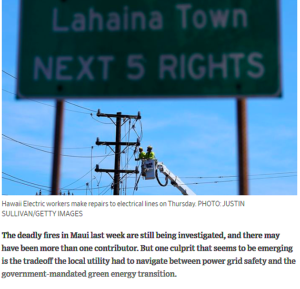COP 28 part 1; a climate reckoning or cop-out
EDITORIAL UPDATE: Dec. 8th, 2023
Today’s growing Climate Crisis is taking all of humankind, regardless of wealth or means, along with most other living things on planet Earth on the path to extinction.
 Yes, extinction is a strong word until one takes the time to review the in-depth scientific findings of human-induced planet-warming. The results of the science are conclusive; a global heating effect is modifying the climate and ny extension, weather predictability (historic in human terms) and stability, impacting both traditional seasons and weather. This growing body of scientific evidence points to climate-conclusive changes now underway and their projected outcome.
Yes, extinction is a strong word until one takes the time to review the in-depth scientific findings of human-induced planet-warming. The results of the science are conclusive; a global heating effect is modifying the climate and ny extension, weather predictability (historic in human terms) and stability, impacting both traditional seasons and weather. This growing body of scientific evidence points to climate-conclusive changes now underway and their projected outcome.
The climate change verdict is out: GUILTY, human-caused burning of fossil fuels has placed our dependency on planetary norms in to a global death spiral. Not since the Holocene period aka the Age of Humans which began about 9,700 years ago has Earth gone through climate changes as the current speed of change, compounded by ever growing GHG emissions in the atmosphere and within the world’s oceans.
The issue of global heating has gone, yes, global, and the COP summit format is evidence of the world’s attention. COP did not happen in vacuum. After a lot of public alarm, the global ratification Paris Climate Accords in 2015, COP (Conference of the Parties) became the next-step vehicle for countries to how best to determine and enact the Paris accords in the transition to global clean energy economy. It also took time and growing public awareness, outside of the world of petro-chemical interests, to conclude that climate action was needed and now: “…something has to be done before it’s too late!”
A consensus response to actions which must be taken sooner, not later was only part of the challenge. There are conflicting interests and contentious issues among all the stakeholders, and this current COP summit hosted by fossil fuel stakeholders is a case in point. Yet, beyond natural barriers to progress, COP is also an opportunity for vested parties to come together on common points of interest, and the threat and realization of climate impacts is now universal, regardless of what you might imagine between governments, science-based climate interests, and competing industrial sectors pitting their profit interests against the future of humanity.
This year’s COP 28 conference is hosted by the oil and gas interests of Dubai.
The current global climate summit got off to rocky start as an excise in arrogance rather than common sense, when the event’s host Sultan Al Jaber, who is also Dubai’s state oil CEO, said this week that “…the phase-out of fossil fuels would take world ‘back into caves” and that “…there is no scientific evidence supporting the phase-out of fossil fuels”… for clean energy alternatives available today, and in the future.
It seems sultan like the words “phased-down” and not out, implying so long as no actionable deadlines to transition off fossil fuels we be put in place, he was all for the summit and its lofty (as many see it) achievable climate goals.
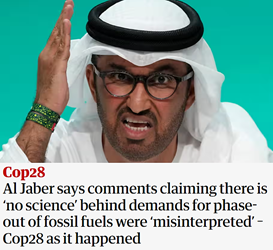 But, this year’s climate summit has also came at a time when 2023 has proven to be the hottest year on record, and a reminder to COP attendees, not only scientists, policy makers, and climate issue specialists, and the fossil fuel interests alike (bankers and other pollution profiteers), that being further comforted knowing the “climate” event is hosted by one of their own, and in one of the largest fossil fuel producing countries in the world, Dubai, may not be enough to hold back rising temperatures and a climate reality, nor a growing consensus that one action is worth a thousand words – and fossil fuels have to go!
But, this year’s climate summit has also came at a time when 2023 has proven to be the hottest year on record, and a reminder to COP attendees, not only scientists, policy makers, and climate issue specialists, and the fossil fuel interests alike (bankers and other pollution profiteers), that being further comforted knowing the “climate” event is hosted by one of their own, and in one of the largest fossil fuel producing countries in the world, Dubai, may not be enough to hold back rising temperatures and a climate reality, nor a growing consensus that one action is worth a thousand words – and fossil fuels have to go!
As opportunity and time run out for actionable global heating remediation, it is shaping up to be a battle for meaningful actions to taken or transition opportunities lost at COP 28.
We can always close our eyes to the world around us, and continue down a path of business-as-usual. But it is becoming increasingly difficult to ignore the path of irreversible global climate consequences we have placed ourselves on. It is no longer a question of if, but when — and that’s something even the Sultan fears most.
The clean or dirty energy choices we make now will determine the livability and outcome for every person alive today. And, if we fail to address this global emergency driven by a 20th century dirty energy economy, the rising costs to society and the environment will be simply unsustainable.
Then there are the diminishing energy benefits from petroleum-gas-coal based energy sources. Rising production, environmental and climate costs point to a dead-end path, and that path is now in sight.
Everyone owns this problem, and anyone believing we can afford to stay the course is increasingly finding a shrinking consensus for cheerleading our present and ongoing reliance on global dirty energy monopolies, their energy sources, and market dependencies they created. People talk of addressing today’s societal inequities, there is no greater wealth inequality than the wealth gap between fossil fuel suppliers and their energy-dependent users.
Disappearing property insurance
American homeowners already coping with extreme weather now face a new risk: disappearing property insurance. Private companies have increasingly reduced coverage, concluding that the risks—and potential losses—threatened by climate change outweigh probable profits. Insurers have increasingly raised fees and reduced coverage, concluding that the risks—and potential losses—threatened by climate change outweigh probable profits
We are entering an age of rising climate costs (directly and indirectly) paid for by both consumers and the planet. The thought that a five cent per gallon increase at the pump will have people up in arms, but ignore the linkage to rising climate risks loaded not only into their direct energy costs, but by extension and example, the present rising turmoil in P&C Insurance market. The Property and Casualty insurance sector now sees costs and risks in different light, as Climate-related claims rise. It has been, until recently, the elephant in the room most people failed to see.
With P&C operating costs now skyrocketing with climate risks and claims on the rise, Insurers are now leaving higher climate risk states, as California is experiencing. The recent deadly Maui fire was a wake-up call for everyone, including within the P&C insurance sector which traditionally thought off Hawaii in terms hurricane risks, and as Hawaii’s Gov. Green recently acknowledged.
 Rising P&C insurance costs are directly linked to housing (and the real estate market in total). Rising insurance costs, and the question of future property insurance costs, and even availability, is just one more example tied to costs of global heating and increasing cost of living factors, which translates into rising insurance costs added into their rent or mortgage payments, into food costs, and into their health costs. Altogether, failure to see the bigger and impactful picture of an economy based on fossil fuels, and continuing to live with fossil fuels wold’s primary energy source.
Rising P&C insurance costs are directly linked to housing (and the real estate market in total). Rising insurance costs, and the question of future property insurance costs, and even availability, is just one more example tied to costs of global heating and increasing cost of living factors, which translates into rising insurance costs added into their rent or mortgage payments, into food costs, and into their health costs. Altogether, failure to see the bigger and impactful picture of an economy based on fossil fuels, and continuing to live with fossil fuels wold’s primary energy source.
Today’s fossil fuel dependencies are further propped-up by false and obsolete economic subsidies and assumptions designed to serve a highly enriched industrial sector of the global economy lined with vested interests. Global taxpayers subsidize annually the fossil industrial sector to the tune of over 7 (seven) Trillion dollars (USD), and those added costs due not include climate heating cost impacts to the global economy and consumers, and the . added pollution and heating the planet. It is an energy path taken, and its past time to get off. Fossil fuels do not need further and massive taxpayer subsidies or be allowed to continue to operate with unabated immunity to the compounding planetary costs and impacts they have created and are creating.
Just one of many real world cause and effect climate examples now underway is are climate-heating impacts now driving droughts now affecting 1.84 billion people throughout the world, according to COP summit findings. And, 85% of the people directly affected are living in low and middle-income countries (LMICs), increasingly linked to social conflicts driven by climate change-induced droughts coupled to social and economic upheaval.
Global food chains are also impacted in the growing combination of factors ranging fueled by rising climate-driven weather global impacts and droughts.
BeyondKona has covered the subject of so-called “Global Warming” since our local publication began in 2017. We have covered the causes and effects of this human-induced crisis affecting the entire planet, Hawaii more specifically. BeyondKona will continue the subject coverage simply because, one; it affects everyone, and two; is too important an issue to ignore with the climate future of Hawaii and the world now at stake.
Bill Bugbee
BeyondKona, Publisher
COP 28 – Recap of Developments; week one:
Day 1: Delegates from nearly 200 countries agreed on details for running the loss and damage fund, a facility designed to help vulnerable countries deal with more extreme weather stoked by global warming.
Day 2: COP28 President Sultan Al Jaber announced the United Arab Emirates will put $30 billion into a climate finance fund called Alterra, which he dubbed a “vehicle like no other.”
Day 3: Exxon Mobil Corp. and Saudi Arabia’s Aramco led a pledge by 50 oil and gas producers to cut emissions from their own operations. Darren Woods was at the summit to discuss the news — marking the first time an Exxon CEO attended a COP.
- Vice President Kamala Harris announced the United States was providing $3 billion in climate aid to poorer nations.
Day 4: The World Bank said it’s working with a club of 15 finance bosses to lower the risk of investing in climate projects in emerging economies and attract private capital for cutting emissions.
Day 5: The COP28 president found “no science” to support the phase out of fossil fuels to keep warming below 1.5C, Al Jaber said he was misunderstood. At a press conference he was joined on stage by Jim Skea, head of the Intergovernmental Panel on Climate Change.
Day 7: Vladimir Putin flew into the UAE — his first trip to the Middle East since he invaded Ukraine — to discuss energy. While he steered clear of COP, the Russian president’s presence in the country was on everyone’s mind at the summit.
In sync with COP 28, President Biden requested more than $11 billion annually to help developing countries cope with the ravages of climate change and transition to clean energy. But lawmakers have so far failed to deliver the funding, with House Republicans voicing steadfast opposition.
A little-known U.S. agency has been leveraging the president’s plan through private-sector partnerships to deliver billions of dollars in climate finance for developing countries. The U.S. International Development Finance Corporation, or DFC, provided $3.7 billion in international climate finance in fiscal year 2023, that equals than a third of President Biden’s original request. “It’s work that, in the aggregate, that has become the backbone of the U.S. government’s overall effort to mobilize climate financing to developing economies,” Jake Levine, DFC’s chief climate officer, revealed.

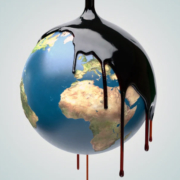
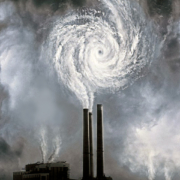
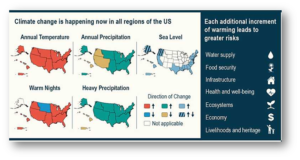 A Fifth National Climate Assessment report issued today by the US government describes how intensifying climate change is disrupting lives and businesses nationwide, even as communities in every state ramp up their response to the crisis:
A Fifth National Climate Assessment report issued today by the US government describes how intensifying climate change is disrupting lives and businesses nationwide, even as communities in every state ramp up their response to the crisis: 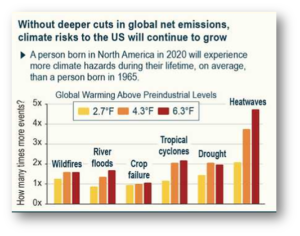 Minor and moderate coastal flooding is also on the rise along most Atlantic and Gulf coastlines, while a combination of rising seas and flooding from high tides and big storms is projected for the the mid-pacific and Hawaiian island chain. Meanwhile, warmer winters are contributing to declining snowpack levels in the Northwest, affecting water supplies.
Minor and moderate coastal flooding is also on the rise along most Atlantic and Gulf coastlines, while a combination of rising seas and flooding from high tides and big storms is projected for the the mid-pacific and Hawaiian island chain. Meanwhile, warmer winters are contributing to declining snowpack levels in the Northwest, affecting water supplies.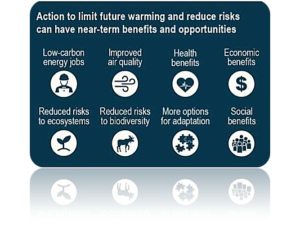 The more warming there is, the worse the impacts will be. Science can’t tell us exactly how hot the planet will get because that depends on what we — society as a whole but especially our political leaders — decide to do. In the US, and elsewhere in the world, people have a choice right now to do more to cut their carbon footprint and prevent much worse warming.
The more warming there is, the worse the impacts will be. Science can’t tell us exactly how hot the planet will get because that depends on what we — society as a whole but especially our political leaders — decide to do. In the US, and elsewhere in the world, people have a choice right now to do more to cut their carbon footprint and prevent much worse warming.
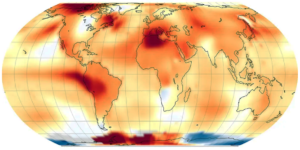 Global sea surface temperatures broke new record highs, and Antarctic sea ice continues its unprecedented meltdown.
Global sea surface temperatures broke new record highs, and Antarctic sea ice continues its unprecedented meltdown. It’s real. It’s happening. It’s accelerating. And it’s our fault. Human activity — particularly the production of greenhouse gasses from fossil fuel emissions — it is reshaping our planet, and Hawaii will not escape the effects of rapid environmental change now occurring at rates never seen before, certainly since humans walked the Earth.
It’s real. It’s happening. It’s accelerating. And it’s our fault. Human activity — particularly the production of greenhouse gasses from fossil fuel emissions — it is reshaping our planet, and Hawaii will not escape the effects of rapid environmental change now occurring at rates never seen before, certainly since humans walked the Earth. The Heat Will Kill You First (2023) warns that extreme heatwaves are becoming more common and are dramatically altering life as we know it – they’re an existential danger. Rising temperatures are already changing the planet, shortening seasons and intensifying disasters.
The Heat Will Kill You First (2023) warns that extreme heatwaves are becoming more common and are dramatically altering life as we know it – they’re an existential danger. Rising temperatures are already changing the planet, shortening seasons and intensifying disasters.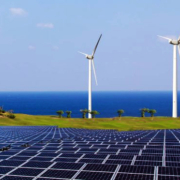

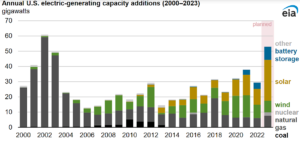 HE’s (HELCO) pattern of bait and switch on its energy transformation path to renewable energy replacements from its fossil fueled power plant investments is a failure when measured in terms of lost clean energy opportunities. It is also a failure of imagination and innovation that extends back into several generations of complicit state PUC – utility decisions. The exception to this period of unenlightened PUC decisions rubber stamping the utility’s poor energy choices, was an all too brief fruitful period of PUC leadership with Jay Griffin, who chaired the Commission from 2019 – 2022, and represented a period of clean energy regulatory leadership and decisions at their best within the state.
HE’s (HELCO) pattern of bait and switch on its energy transformation path to renewable energy replacements from its fossil fueled power plant investments is a failure when measured in terms of lost clean energy opportunities. It is also a failure of imagination and innovation that extends back into several generations of complicit state PUC – utility decisions. The exception to this period of unenlightened PUC decisions rubber stamping the utility’s poor energy choices, was an all too brief fruitful period of PUC leadership with Jay Griffin, who chaired the Commission from 2019 – 2022, and represented a period of clean energy regulatory leadership and decisions at their best within the state.
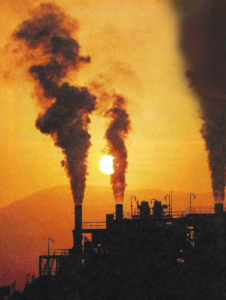
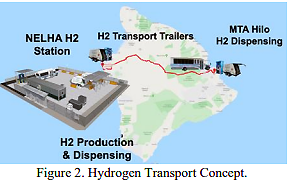

 Kilauea, one of the most active volcanoes in the world, began erupting Sunday, September 10th, after a two-month pause, displaying glowing lava that is a safe distance from people and structures in a national park on the Big Island, but lasted only about one week.
Kilauea, one of the most active volcanoes in the world, began erupting Sunday, September 10th, after a two-month pause, displaying glowing lava that is a safe distance from people and structures in a national park on the Big Island, but lasted only about one week. 
 Kīlauea Erupts After a 3 Month Pause
Kīlauea Erupts After a 3 Month Pause Opening phases of volcanic eruptions are generally dynamic, and Kilauea did not disappoint USGS scientists or the general public.
Opening phases of volcanic eruptions are generally dynamic, and Kilauea did not disappoint USGS scientists or the general public. Vog is primarily a mixture of sulfur dioxide (SO2) gas and sulfate (SO4) aerosol. SO2 (invisible) reacts with oxygen and moisture in the air to produce SO4 aerosol (visible).
Vog is primarily a mixture of sulfur dioxide (SO2) gas and sulfate (SO4) aerosol. SO2 (invisible) reacts with oxygen and moisture in the air to produce SO4 aerosol (visible). Kilauea’s eruptive volcanic emissions, especially sulfur dioxide, can also turn local area skies into a strange yellow hazy tint, and when the tainted air comes in contact with cars and buildings. for example, it leaves a toxic residue or hazy coating on windows and can damage painted surfaces, including vehicles, and harmful to agriculture.
Kilauea’s eruptive volcanic emissions, especially sulfur dioxide, can also turn local area skies into a strange yellow hazy tint, and when the tainted air comes in contact with cars and buildings. for example, it leaves a toxic residue or hazy coating on windows and can damage painted surfaces, including vehicles, and harmful to agriculture.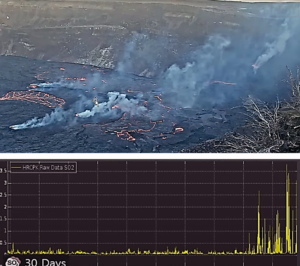

 Maui residents cope with loss and come together, as local government response stumbles.
Maui residents cope with loss and come together, as local government response stumbles.

 Lahaina, Maui: Before
Lahaina, Maui: Before Lahaina, Maui: After
Lahaina, Maui: After South Kohola, Hawaii Island (Maui in the distance)
South Kohola, Hawaii Island (Maui in the distance)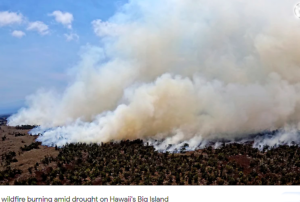 South Kohola, Hawaii Island
South Kohola, Hawaii Island


 The PGV power plant, Puna Geothermal Venture, began commercial operation 25 years ago despite objections from local residents who are concerned by the company’s non-stop geothermal drilling and operations. The release of geothermal fluids and toxic hydrogen sulfide emissions, direct side effects of the company’s operations are key concerns of nearby residents. Recently, HELCO has proposed increasing the capacity charges for PGV under the new contract which will impact savings projections as they no longer receive the avoided cost of oil. Consumers islandwide would be impacted.
The PGV power plant, Puna Geothermal Venture, began commercial operation 25 years ago despite objections from local residents who are concerned by the company’s non-stop geothermal drilling and operations. The release of geothermal fluids and toxic hydrogen sulfide emissions, direct side effects of the company’s operations are key concerns of nearby residents. Recently, HELCO has proposed increasing the capacity charges for PGV under the new contract which will impact savings projections as they no longer receive the avoided cost of oil. Consumers islandwide would be impacted. Even today, the East Rift Zone is seeing inflation as new magma is intruded below the surface. A very dynamic situation. Something PGV’s investors will need to consider as drilling is neither cheap nor results guaranteed. Investors will be needed to spend even more on PGV to replace existing power generation much less the funds for expansion. More on drilling, too. This uncertainty and risk goes beyond just nervous investors as ratepayers are paying for expensive fossil fuel generation in the meantime.
Even today, the East Rift Zone is seeing inflation as new magma is intruded below the surface. A very dynamic situation. Something PGV’s investors will need to consider as drilling is neither cheap nor results guaranteed. Investors will be needed to spend even more on PGV to replace existing power generation much less the funds for expansion. More on drilling, too. This uncertainty and risk goes beyond just nervous investors as ratepayers are paying for expensive fossil fuel generation in the meantime.


